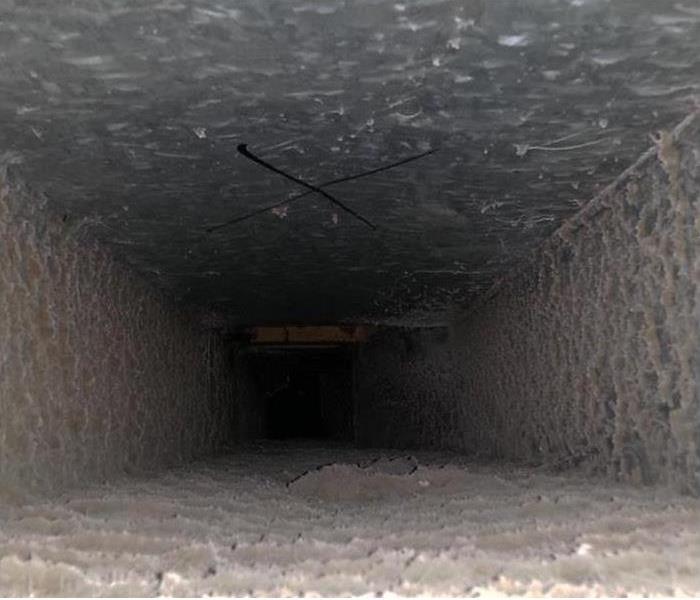Mold and Your Commercial Property's HVAC System
2/2/2018 (Permalink)
While mold growth in a commercial facility can be the result of a variety of factors, its HVAC system is often the culprit. With their extensive assemblage of drain pans, ducts, piping, filters and heat exchangers, these systems can provide an ideal environment for mold growth if they are not properly maintained. They also offer a convenient pathway for mold spores that can allow them to spread throughout the facility. For effective mold prevention, detection and removal, it is vital that facility managers have a good understanding of mold and how it interacts with an HVAC system.
UNDERSTANDING MOLD
Mold is always present; it is considered a problem when growth is visible on interior surfaces, reaches excessive levels or features species different from those present in outside air. To flourish, mold requires an acceptable temperature, a food source and sufficient moisture. Unfortunately, the temperatures that people prefer to maintain indoors are conducive to mold growth. Food sources like wood, paper, cardboard, fabric, carpeting, furnishings and drywall are also readily available in most buildings. This means that controlling or eliminating moisture is the best strategy for preventing mold growth.
ASSESSING YOUR HVAC SYSTEM FOR MOLD
Issues with the design, installation or maintenance of its HVAC system can leave a commercial facility vulnerable to mold. When assessing the HVAC system for mold, there are several key components that should be inspected, including:
Drain pans and coils. Cooling cools pull humidity from the air. The resulting condensate water should drip into a drain pan and exit the system via a deep seal trap, but improper design or maintenance of the drain pain can result in standing water, an ideal microbial habitat. Proper sloping and regular cleaning of the drain pan allow it to function appropriately.
Dehumidification equipment. The wet surfaces found here can supply the moisture necessary for mold growth. Periodically treating them to prevent microbial growth is crucial, but care must be taken to avoid dampening duct linings.
Cooling towers. Water quality monitoring and periodic chemical treatment can help prevent microbial growth. If sediment accumulation is an issue, physical cleaning may also be required.
Outdoor air dampers. Debris on screens and grills can build up, blocking them and providing a harbor for mold growth. Regular cleaning can head off potential problems.
Ducts. While some dust is to be expected, areas that are subject to restricted airflow or moisture are susceptible to contamination. Spaces with duct lining can also be more vulnerable. To avert trouble, maintain filters, coils and drip pans, protect key system components from moisture accumulation, and repair any water damage promptly. It also helps to minimize the buildup of dust and debris by performing the appropriate housekeeping, especially during any renovation or construction.
Air filters. To prevent contaminants from entering the system, filters should fit properly and match the expected airflows. They need to be changed regularly, and fans should be shut off during the process to avoid contamination.
Air intakes. Groupings of organic material in or near HVAC intakes should raise a red flag. Droppings from birds or bats and debris from areas near garbage cans, standing rain water, drainage ponds, vegetation or freshly disturbed earth can result in elevated levels of airborne fungal spores. Return-air plenum. The space above ceiling tiles is often employed as a return-air plenum, so it is important to follow the code that restricts material in the plenum to avoid contamination and ensure uninterrupted airflow.
DEALING WITH MOLD
The interior structures of commercial HVAC systems offer numerous reservoirs where moisture can linger, creating a perfect environment for mold, and remediation can be incredibly challenging. If mold cleanup is required, it is critical that it be completed by trained workers who have the right tools for the job because the proper use of isolation procedures, decontamination methods and personal protective equipment is crucial. If done incorrectly, attempts at mold removal can damage components of the HVAC system and may actually spread the mold spores to new areas. Many facility managers prefer to rely on professional mold remediation services.
SERVPRO’S PROFESSIONAL MOLD REMEDIATION SERVICES
If you suspect that your HVAC system or any other part of your commercial property has been contaminated by mold, turn to the professionals at SERVPRO. Our experienced technicians are fully certified, so you can be confident that they have the knowledge and expertise needed to tackle even the toughest mold problems. When you contact us for mold remediation services, we will:
• Respond promptly. • Perform an expert assessment to pinpoint the locations of visible and hidden mold. • Use advanced containment methods to isolate areas with active fungal growth and prevent the spread of the mold. • Remove microscopic mold spores from the air with specialized filtration equipment. • Apply anti-fungal treatments to eliminate mold growth and properly dispose of any mold-infested materials that cannot be salvaged. • Employ a variety of techniques to clean and sanitize any affected items and deodorize the area. • Provide restoration services that return the area to its preloss condition.
At SERVPRO, we take pride in being your best resource for mold remediation. If water or fire has damaged your property, our commercial restoration services can get you back in business fast. With more than 40 years in the industry, an award-winning training program, a variety of specialized cleaning services, we are ready to tackle your most challenging jobs. Offering 24/7 emergency services, we are there whenever you need us, and you can always count on our professional team to leave your commercial property looking its best. Call us today to explore our full range of services or request our assistance.

 24/7 Emergency Service
24/7 Emergency Service
